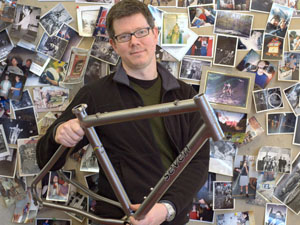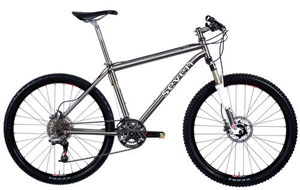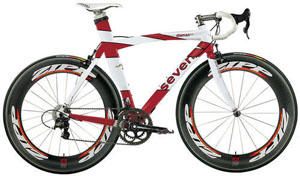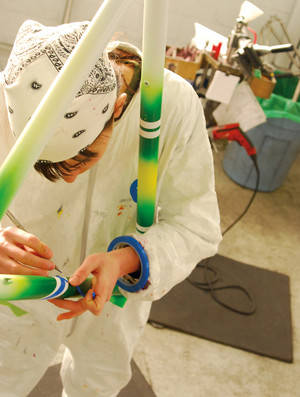bikeradar.com
By Marcus Farley & James Costley-White

Massachusetts-based Seven Cycles have been hand-crafting high-end custom bikes from steel, titanium and carbon fibre since 1997.
They’ve built such a reputation for themselves that they’re now the largest exclusively custom frame builders in the world.
We spoke to founder and president Rob Vandermark about Seven’s exciting new suspension partnership with Dave Weagle, their 2010 range and his bike building philosophy.
So Rob, we hear your new full-suspension mountain bikes will feature a new suspension design…
Our new suspension partnership is with Dave Weagle. Our co-designed bike line is really exciting and innovative. Working with Dave’s vast suspension knowledge in conjunction with Seven’s manufacturing and customisation capabilities has lead to a really innovative outcome: unique and individualised rider-specific suspension tuning and ride feel.
Because of this, Seven are introducing an entirely new series of suspension bikes with some design concepts that have never before been available. We’re really excited about this partnership.
You used to use Maverick’s design. What prompted the change?
Yes, in fact we were the first company – in 2001 – to offer both a titanium Maverick Monolink design and a full-custom geometry version. At that point in suspension’s evolution, the Monolink was a complete departure from how other technologies addressed suspension. Maverick provided a number of advantages with none of the typical shortcomings.
Working with the Maverick team has been a great partnership… [but] all successful products go through a cycle from introduction to growth, maturity and decline, until the lifecycle begins all over again. We’d worked with Maverick for a long period, and the time came to look at dual suspension from a different perspective.
Dave’s experience and reputation for developing technologies such as dw-link and Split Pivot made him an obvious choice. So, we contacted each other and found we each had some compelling ideas about working together. We are also fortunate that both our companies are based in Massachusetts, which makes collaborating easier.
Can you give us any more details of the new platform?
We are licensing the Split Pivot design fully intact; we can’t see any reason to modify the system because it’s a great design. The piece that Seven bring to the design is the way in which we’re tailoring the suspension system for the rider – and the way in which we integrate that suspension into the overall design of the bike.
We’ve developed a holistic order method that enables the customer to specify the suspension characteristics in exactly the same way that we do with the ride characteristics and handling of our non-suspended bikes. To us this is exciting because we’re designing the suspension feel for each rider as an integrated element of the entire bike and rider combination.
A few of the ways we’re adapting the suspension characteristics individually are by tailoring placements of pivot locations on each customer’s frame, integrating overall frame geometry and handling characteristics, matching to the customer’s fork choice, and accounting for key component selections.
These are just a few examples of how we’re optimising the Split Pivot system for the rider; there are many other factors involved but that’s a bit of an overview of how we’re approaching this new design.

For 2010 Seven offer 27 models across seven categories: triathlon, road, commuting, touring, tandeming (road and mountain), cyclo-cross and mountain bikes (dual suspension and hardtail).
[There are]… a number of improvements such as a new curved down tube on all our mountain bike models, a distinct triathlon model series and a new category we refer to as Traveler, whose models are designed for off-road expeditions, loaded touring, urban commuting and anything in between.
We’ve expanded our component offerings with new handlebars, seatposts, stems and forks, in a variety of materials and custom options.
As far as unannounced new products, our manufacturing approach allows us to make rapid product introductions, so you will continue to see new offerings added throughout the year, not just during the fall. Stay tuned to see what we have in store.
Where do you see Seven heading in future?
Because the industry is changing faster than ever, we’re sure that the next five years will be really unpredictable and exciting for riders. Fortunately, we have a five-year R&D plan. Each season our R&D plan shifts depending on customer interests, industry component design changes, and our own internal capability improvements.
A few items on our list, without giving too much away, include: we’re working on some interesting frame and component integration technologies; we’re beta testing some new service methodologies that will change the way we work with customers for the better; we’ll be augmenting our suspension bike offerings and the tune-ability of the suspension systems; we’re developing more components that relate to our frame designs; and we’ve got some big road bike technologies in development.
And yes, there is a new frame material on the near horizon [Seven currently offer bikes in full-carbon, carbon-and-titanium, titanium or steel] – but we’re not discussing it yet.

How are you coping with the credit crunch?
The situation seems to be improving, but the lack of visibility – for next week or next quarter – affects us just as it affects businesses of all sizes. We are fortunate to maintain good long-term relationships with our suppliers and retail partners. Our current approach is not so different from how we normally work, but we communicate more frequently and in greater depth than before.
Like all companies, we seek to reduce unnecessary expenditure wherever possible – except in R&D. Sometimes we change the resource mix for a project or adjust a product introduction timeline, but our ability to adapt quickly makes us better positioned to deal with this type of uncertainty.
Tell us more about Seven Cycles, and how you came to found it…
I’ve been a cyclist my entire life. Cycling became a vocation for me while working in a bike shop during high school and college. I majored in sculpture at the Massachusetts College of Art and The School at the Museum Of Fine Arts, Boston. I left school when I realised I could combine my two passions – cycling and sculpture – in a career of bicycle design and frame building.
Prior to participating in founding Seven, I served as head of R&D at Merlin Metalworks, a high-end bicycle frame builder and one of the first to work with titanium. During the 10 years I worked at Merlin, I was able to work in all aspects of bicycle frame building and design, from machining and welding to product development and process improvement.
I decided to leave Merlin at the close of 1996 because the company began focusing on the mainstream market at the same time that I was becoming more interested in pushing the limits of bike customisation, technology transfer and the Toyota Production System of manufacturing. I really wanted to see how these three ideas could converge in a new and successful way. Four of us started Seven in January 1997. The business has grown steadily over the years.

Where did the name come from?
It’s interesting how the meaning and origin of our name has generated so many myths, which are almost universally untrue. Seven Cycles does not refer to the number of people who started the company, nor the number of days a week we work.
We were brainstorming many different names and for some reason the number seven came up in various combinations on several people’s lists. We selected it because seven is considered a lucky number in many cultures, and there was no pre-existing definition behind the name – we could create our own unique meaning for the company.
Seven specialise in hand-built custom design. Is this your philosophy for everything in life as well as bike building?
Seven’s approach to customisation is unusual. For us, custom fit is just one small piece of the overall experience. We also invest a lot of energy in customising – and optimising – the bike’s tubeset, ride characteristics, handling, performance aspects, aesthetics, build kit, and even our relationship with each rider. Our focus is on exceeding each custmer’s expectations; part of our job is to act as advisors and consultants during the rider’s bike purchase, down to the last detail.
From a manufacturing standpoint, by having each of Seven’s framebuilders focus on only one bike at a time, we have better quality control, fewer defects caused by batch processing, less waste, real-time innovation and product improvements, as well as process improvements – quite a few advantages, really. It’s fundamentally a more customer-centric philosophy to offer a built-to-order bike for each and every rider. Custom building is important to Seven because it provides a better customer experience and it’s better for the planet.
Your next question asks whether that’s my, or Seven’s, philosophy for everything in life. For me personally, I say, “Yes”. I always try to start with a customer-centric resource allocation perspective. By way of non-Seven real world example: a coffee house. How does a customer discern the milk from the skim? How does the business dispense napkins – and in what size? And on, and on. Seriously; it’s an illness I have!
How locally do you source your materials? and what’s Seven’s carbon footprint like?
We source more than 90 percent of our materials from within the United States. More than 30 percent of the total material value comes from within 100 miles of Seven’s factory. In addition, well over 90 percent of the material manipulation and machining – both have major carbon footprints – are performed either in-house or within 100 miles. And, by the way, every one of our frames is made in the United States.
On the carbon footprint front, because of our single-piece-flow and just-in-time manufacturing systems, we create very little waste during fabrication. Even so, we are extremely mindful of our carbon footprint and our overall ecological footprint. We minimise our environmental impact by using petroleum-free cutting fluids, paint recapturing, recycling and filtration systems.
In fact, we reuse or recycle just about anything you can think of: paper, plastic, metal scrap and shavings, wood, cardboard and coolants. And, of course, we incentivise employees to commute to work by bike.
